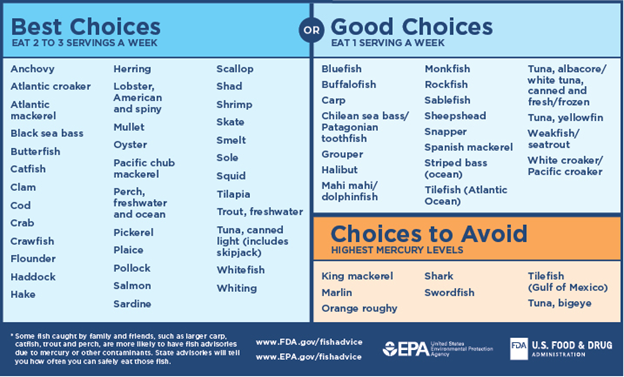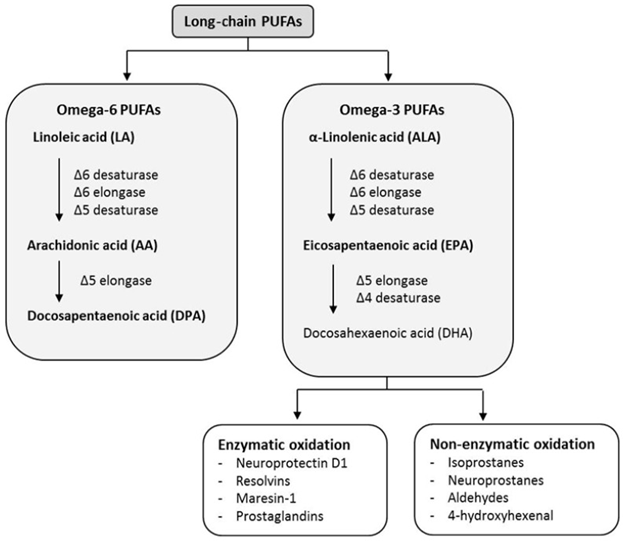Supplementing with omega-3s is a common practice and often recommended for those at risk for cardiovascular disease (CVD) and inflammatory disorders. Indeed, research suggests that omega-3 fatty acids and their derivatives may be of benefit not only in CVD and inflammation but also in obesity, type 2 diabetes, insulin resistance, and even autoimmune diseases such as multiple sclerosis and lupus. [1] [2] [3]
Fish or marine oils provide long-chain omega-3s EPA and DHA, compounds associated with
However, there is debate over whether humans need to only consume the essential omega-3 precursor alpha-linolenic acid (ALA), or its potentially conditionally essential metabolites EPA and DHA.
At present, the United States only defines a DRI recommendation (adequate intake) for ALA: 1100 mg/day for women and 1600 mg/day for men. However, the NIH does recognize that production of EPA and DHA is limited in humans and they note that “consuming EPA and DHA directly from foods and/or dietary supplements is the only practical way to increase levels of these fatty acids in the body due to poor conversion from ALA. The NIH notes that:[4]
Is seafood a safe source of Omega-3 EPA and DHA?
Consumption of 5.5 ounces of oily fish containing omega-3s (e.g. salmon, mackerel, sardines, herring, trout, tuna) can provide 2 grams of EPA/DHA. This modest amount consumed 2-3 times/week can be healthy for the heart and mind.[5]
However, larger fish such as kingfish, swordfish, tilefish, and shark, can bioaccumulate toxins including mercury, dioxins, and PCBs, and should be minimized or eliminated from the diet.[6] [7] Current US Dietary guidelines recommend at least 8 ounces of seafood weekly, preferably from lower mercury sources.[8]

FDA. Advice about Eating Fish. https://www.fda.gov/food/consumers/advice-about-eating-fish
What about consuming just ALA instead of EPA and DHA?
While ALA is considered essential and serves as a precursor to EPA and DHA, conversion in humans is inadequate to meet needs.[9]
ALA can be found in healthy foods such as chia seeds, flaxseeds, hemp, and walnuts and these foods provide beneficial nutrients and compounds besides ALA. However, ALA content does not appear adequate to meet humans’ long-chain omega-3 EPA and DHA needs.[10]

Source: Sokoła-Wysoczańska, Ewa et al. “Polyunsaturated Fatty Acids and Their Potential Therapeutic Role in Cardiovascular System Disorders-A Review.” Nutrients vol. 10,10 1561. 21 Oct. 2018 This article is an open access article distributed under the terms and conditions of the Creative Commons Attribution (CC BY) license (http://creativecommons.org/licenses/by/4.0/).
What does the research say?
Safety and purity of fish oil supplements
Exposure to oxygen, light, and heat can cause oxidation and rancidity, while bioaccumulation increases toxicity in seafood. Elevated levels of toxins and oxidation byproducts may be present in supplements produced with substandard manufacturing practices.
In the United States, 27% of fish oil supplements evaluated had lipid peroxide levels that exceeded international standards. Maximum limits for oxidation byproducts are set by the GOED (Global Organization for EPA and DHA Omega-3s).[17] Researchers suggest that some studies in the past may have unwittingly used oxidized fish oil, invalidating clinical results.
Interestingly, two randomized, double-blind, placebo-controlled trials found that doses of oxidized fish oil of 8 grams per day did not result in elevated biomarkers of oxidative stress during a seven-week supplementation period.[18]
Still, it is important for consumers and practitioners to choose supplements that have been tested for toxins such as mercury, dioxins, PCBs, and oxidation compounds. Companies should provide this information on demand.[19]
CLICK HERE to learn more about the Omega-3 Index, health consequences, the ODX ranges, etc.
Happy fishing!
[1] Sokoła-Wysoczańska, Ewa et al. “Polyunsaturated Fatty Acids and Their Potential Therapeutic Role in Cardiovascular System Disorders-A Review.” Nutrients vol. 10,10 1561. 21 Oct. 2018, [R]
[2] Anderson, Breanne M, and David W L Ma. “Are all n-3 polyunsaturated fatty acids created equal?.” Lipids in health and disease vol. 8 33. 10 Aug. 2009, [R]
[3] Abedi, Elahe, and Mohammad Ali Sahari. “Long-chain polyunsaturated fatty acid sources and evaluation of their nutritional and functional properties.” Food science & nutrition vol. 2,5 (2014): 443-63. [R]
[4] Omega-3 Fatty Acids Fact Sheet for Health Professionals. Retrieved September 8, 2020 from [R]
[5] Tvrzicka, Eva, et al. "Fatty acids as biocompounds: their role in human metabolism, health and disease-a review. part 1: classification, dietary sources and biological functions." Biomedical Papers of the Medical Faculty of Palacky University in Olomouc 155.2 (2011). [R]
[6] Committee on a Framework for Assessing the Health, Environmental, and Social Effects of the Food System; Food and Nutrition Board; Board on Agriculture and Natural Resources; Institute of Medicine; National Research Council; Nesheim MC, Oria M, Yih PT, editors. A Framework for Assessing Effects of the Food System. Washington (DC): National Academies Press (US); 2015 Jun 17. ANNEX 1, DIETARY RECOMMENDATIONS FOR FISH CONSUMPTION. Available from: https://www.ncbi.nlm.nih.gov/books/NBK305180/
[7] Bays, Harold E. “Safety considerations with omega-3 fatty acid therapy.” The American journal of cardiology vol. 99,6A (2007): 35C-43C. [R]
[8] FDA. Advice about Eating Fish. Retrieved September 6, 2020 from [R]
[9] Committee on a Framework for Assessing the Health, Environmental, and Social Effects of the Food System; Food and Nutrition Board; Board on Agriculture and Natural Resources; Institute of Medicine; National Research Council; Nesheim MC, Oria M, Yih PT, editors. A Framework for Assessing Effects of the Food System. Washington (DC): National Academies Press (US); 2015 Jun 17. ANNEX 1, DIETARY RECOMMENDATIONS FOR FISH CONSUMPTION. Available from: https://www.ncbi.nlm.nih.gov/books/NBK305180/
[10] Sokoła-Wysoczańska, Ewa et al. “Polyunsaturated Fatty Acids and Their Potential Therapeutic Role in Cardiovascular System Disorders-A Review.” Nutrients vol. 10,10 1561. 21 Oct. 2018, [R]
[11] Lin, Zhijing et al. “Cardiovascular Benefits of Fish-Oil Supplementation Against Fine Particulate Air Pollution in China.” Journal of the American College of Cardiology vol. 73,16 (2019): 2076-2085. [R]
[12] Ghasemi Fard, Samaneh, et al. "How does high DHA fish oil affect health? A systematic review of evidence." (2019). [R]
[13] Akintoye, Emmanuel et al. “Fish Oil and Perioperative Bleeding.” Circulation. Cardiovascular quality and outcomes vol. 11,11 (2018): e004584. [R]
[14] Larrieu, Thomas, and Sophie Layé. “Food for Mood: Relevance of Nutritional Omega-3 Fatty Acids for Depression and Anxiety.” Frontiers in physiology vol. 9 1047. 6 Aug. 2018, [R]
[15] Davinelli, Sergio et al. “Metabolic indices of polyunsaturated fatty acids: current evidence, research controversies, and clinical utility.” Critical reviews in food science and nutrition, 1-16. 14 Feb. 2020, [R]
[16] von Schacky, Clemens. “Omega-3 index and cardiovascular health.” Nutrients vol. 6,2 799-814. 21 Feb. 2014, [R]
[17] Cameron-Smith, David et al. “Fishing for answers: is oxidation of fish oil supplements a problem?.” Journal of nutritional science vol. 4 e36. 23 Nov. 2015, [R]
[18] Ismail, Adam, et al. "Oxidation in EPA‐and DHA‐rich oils: an overview." Lipid Technology 28.3-4 (2016): 55-59. [R]
[19] Life Extension IFOS Report. Retrieved September 11, 2020 from [R]